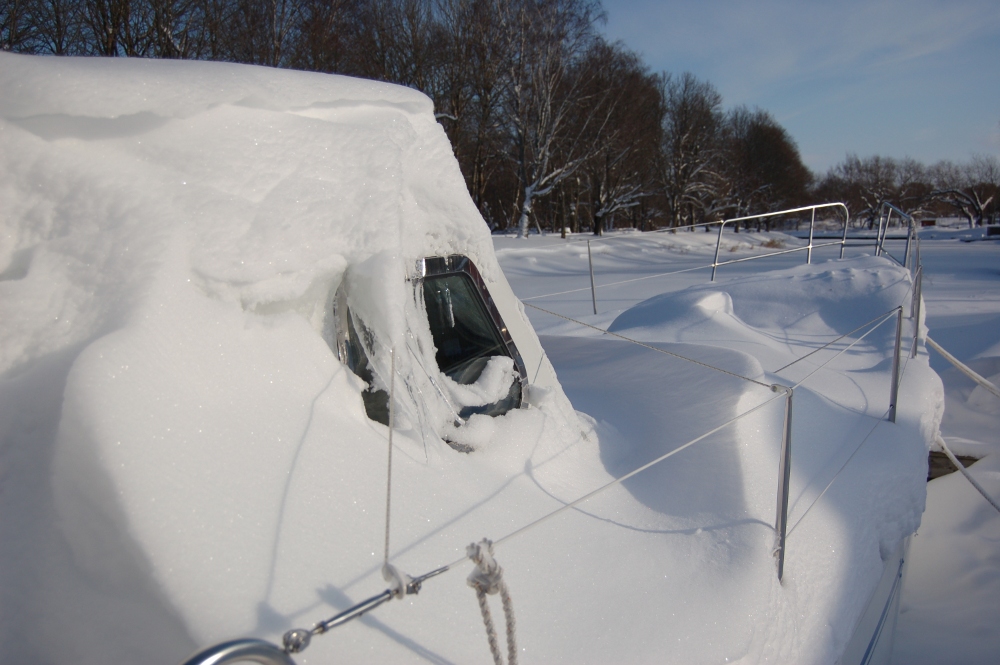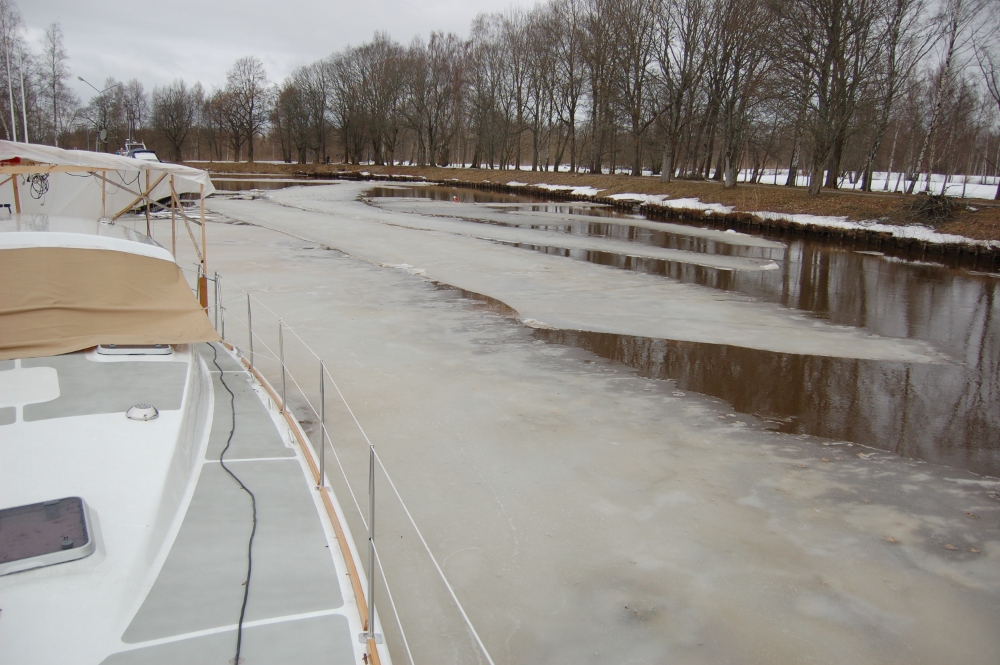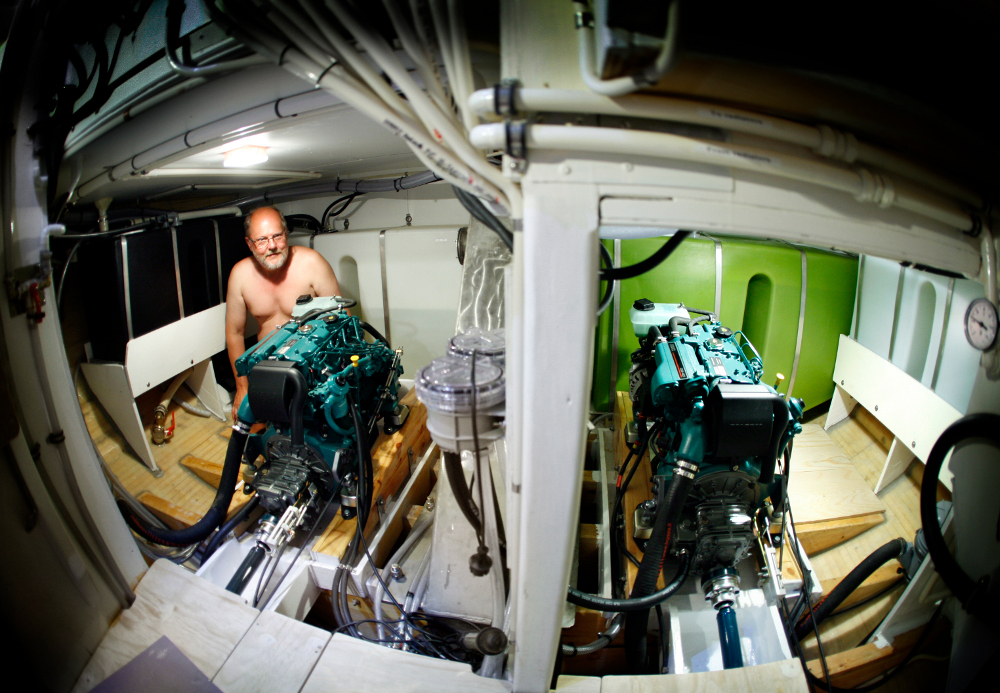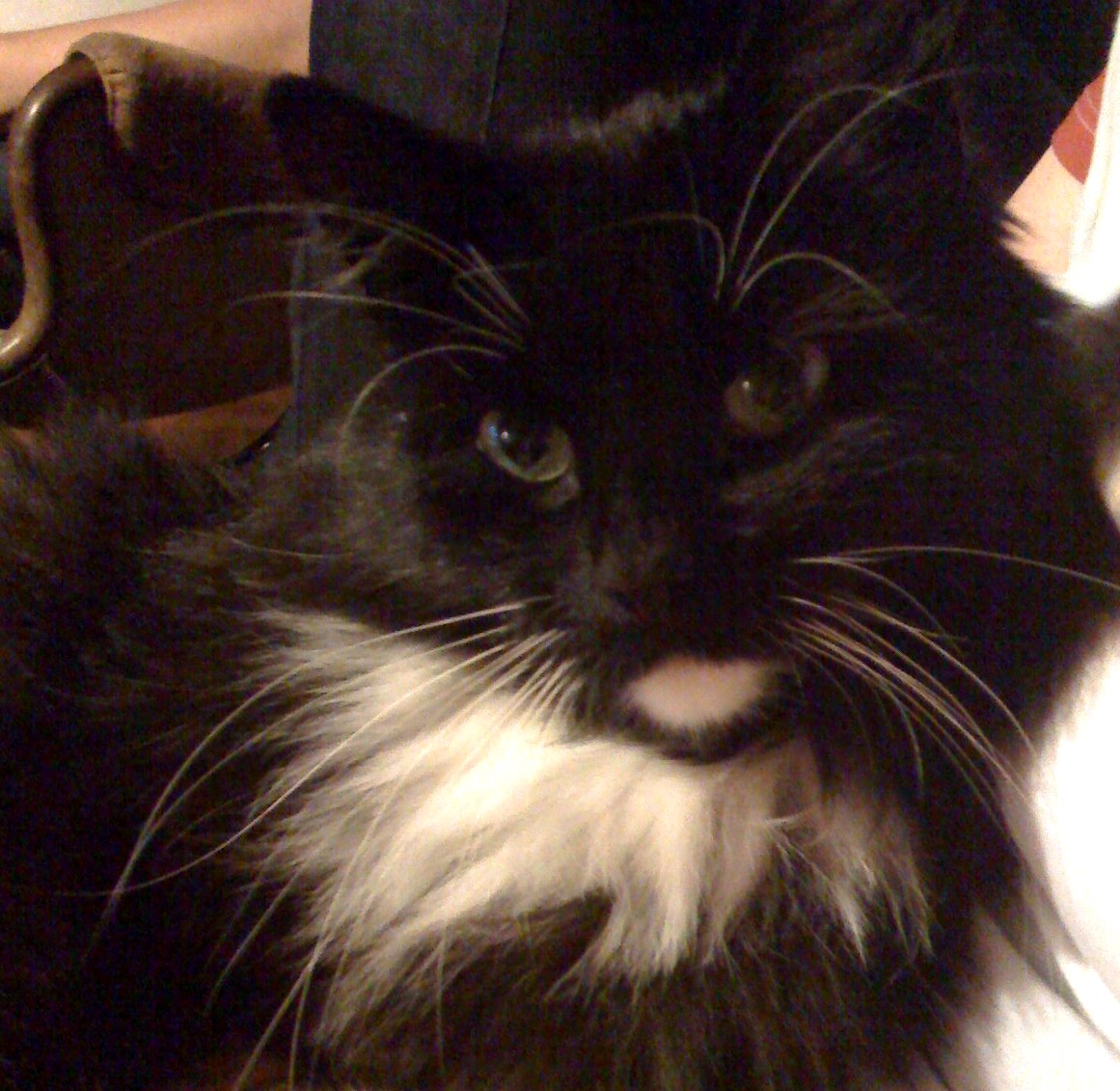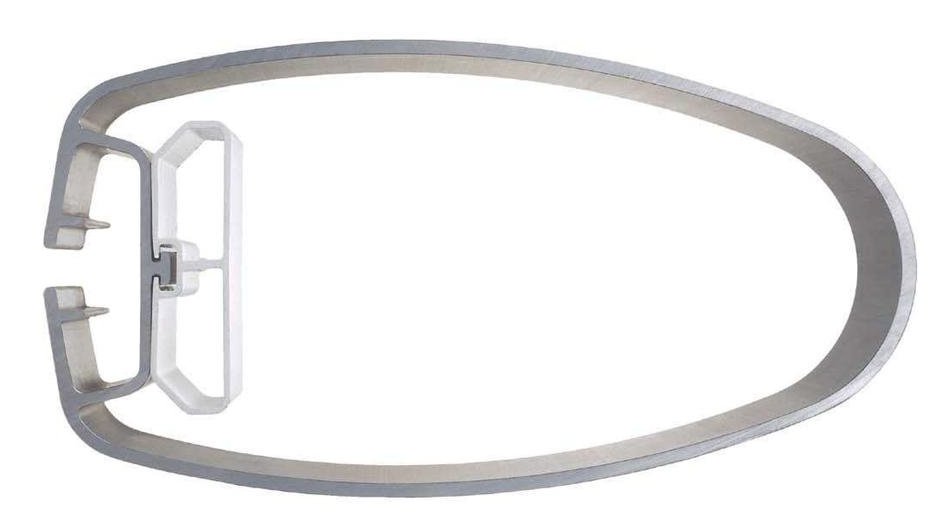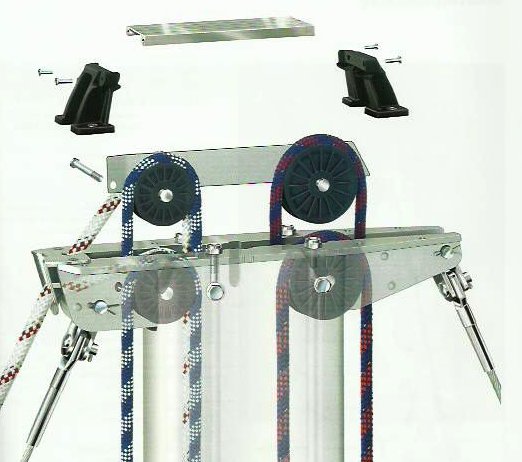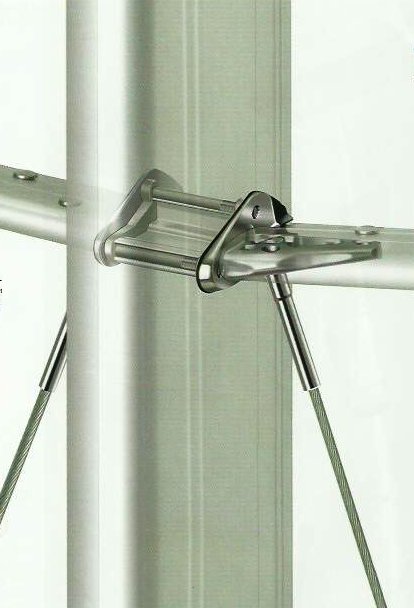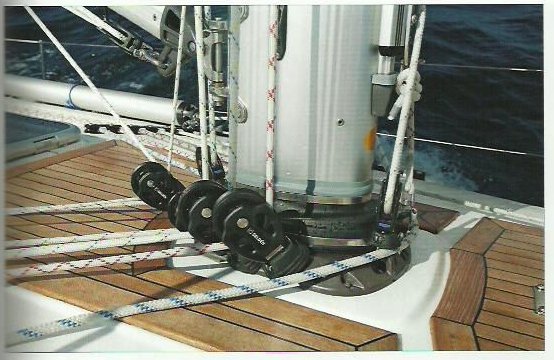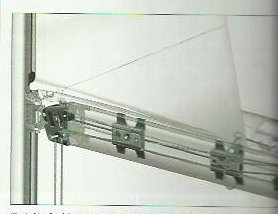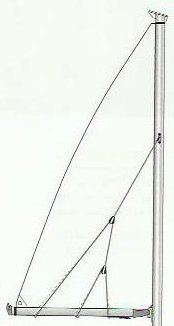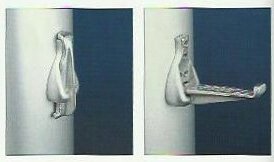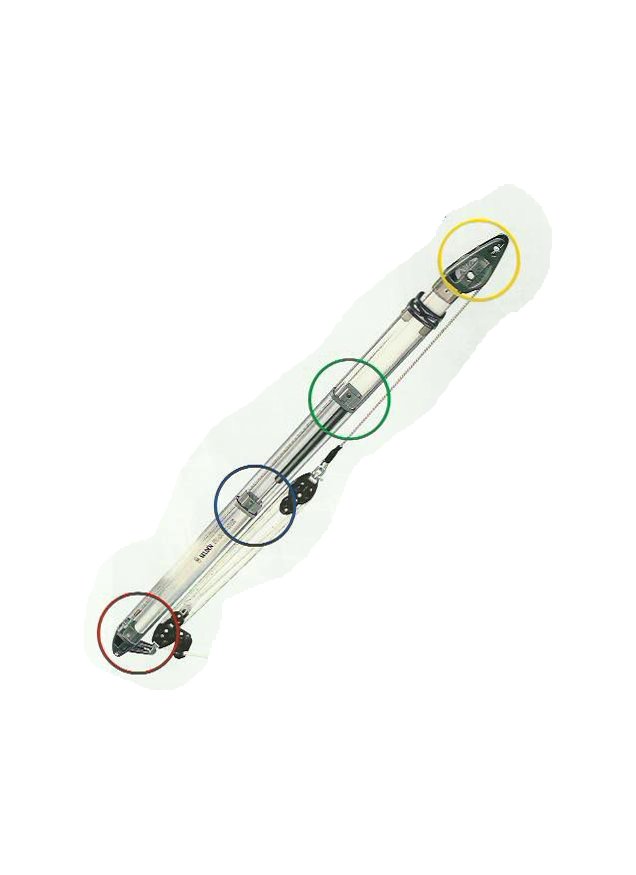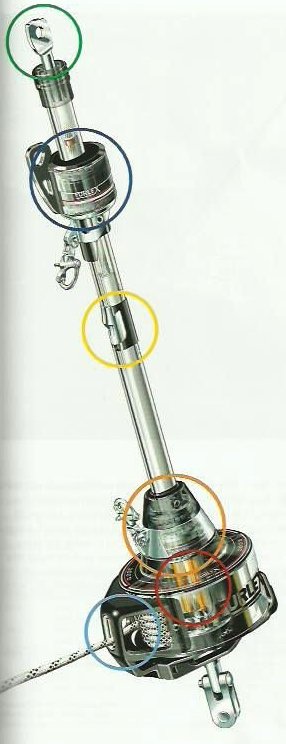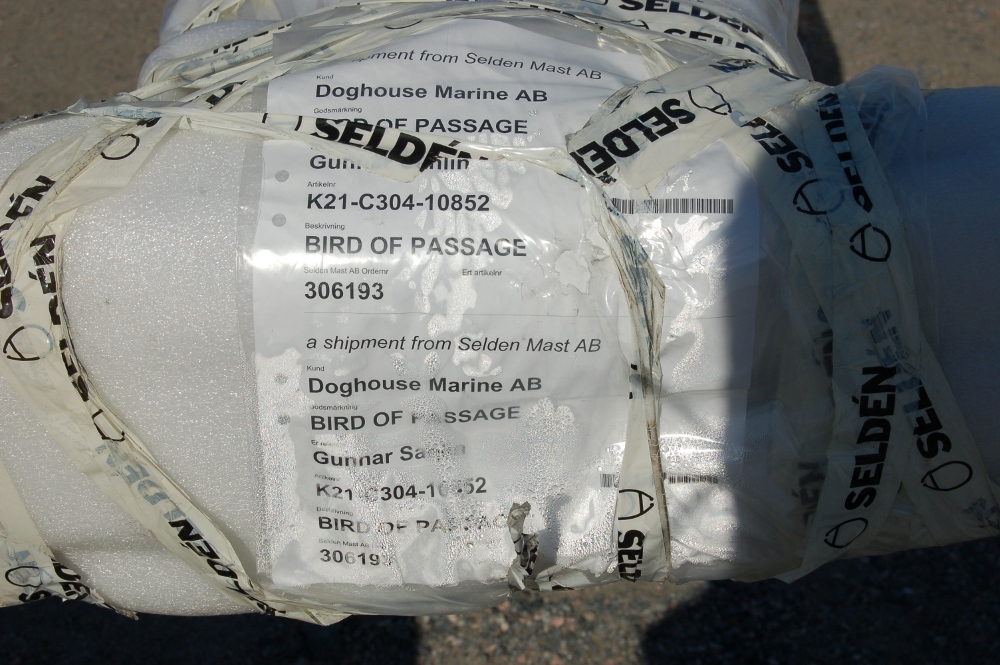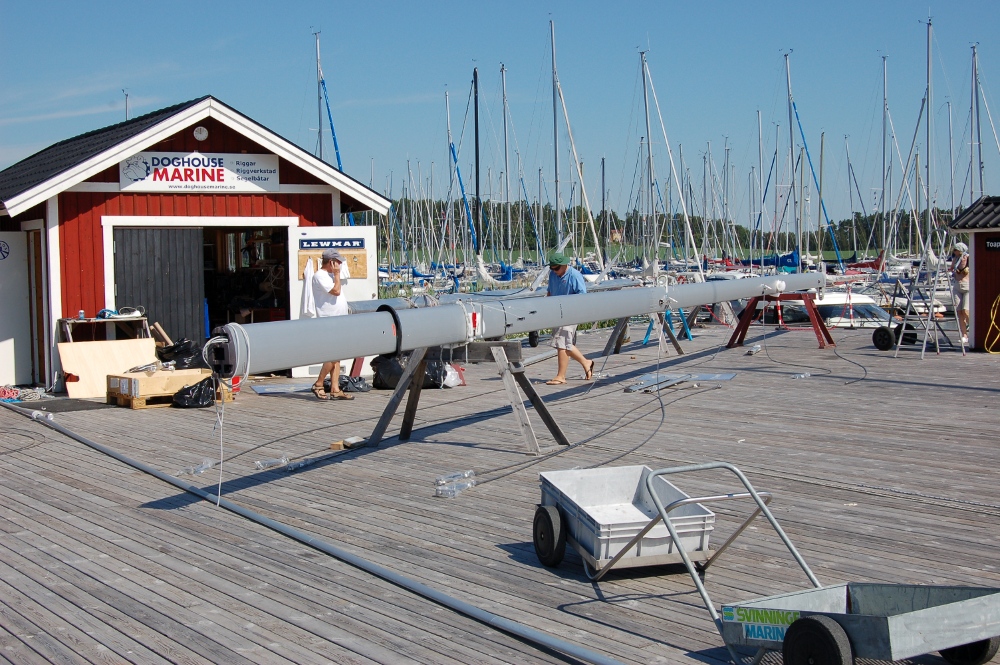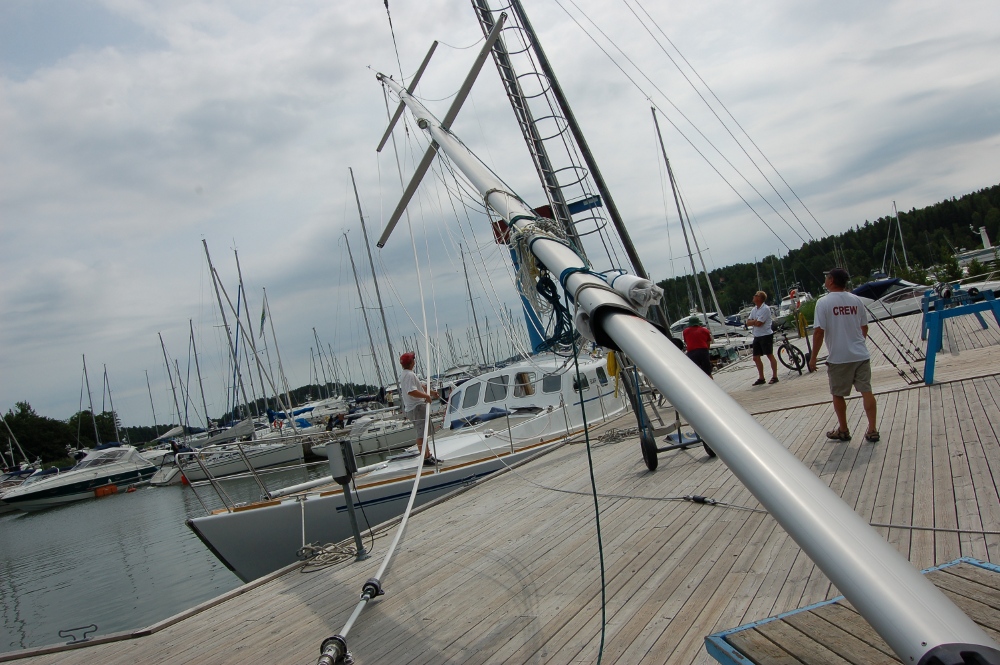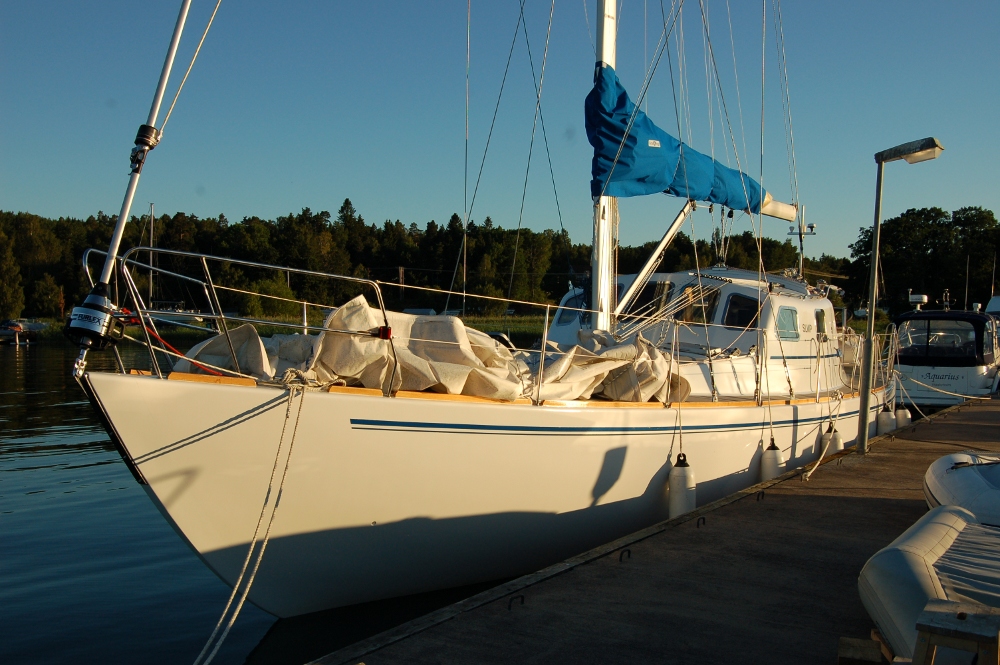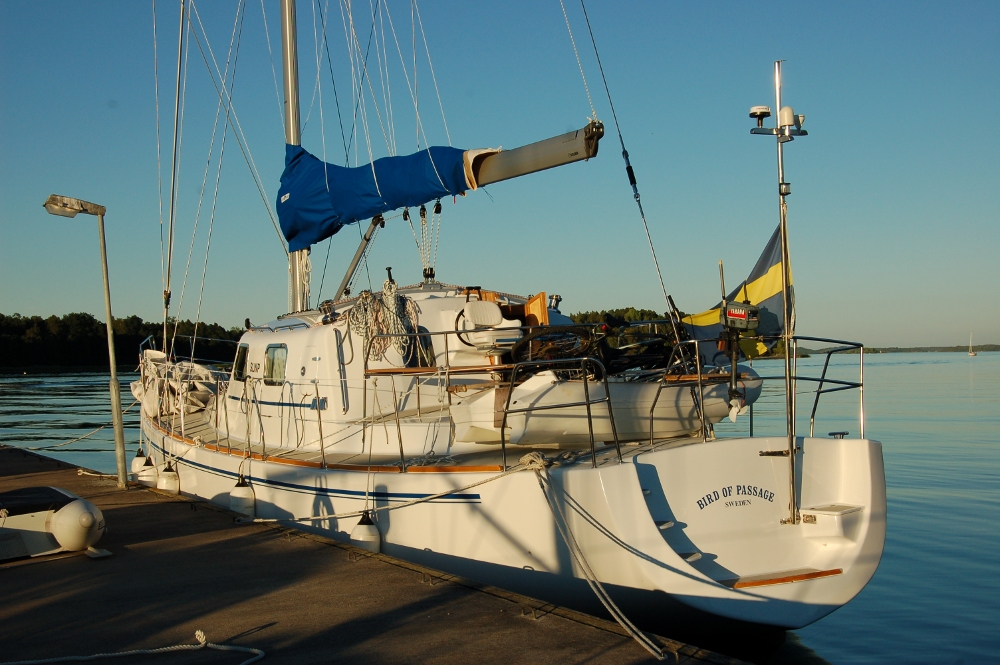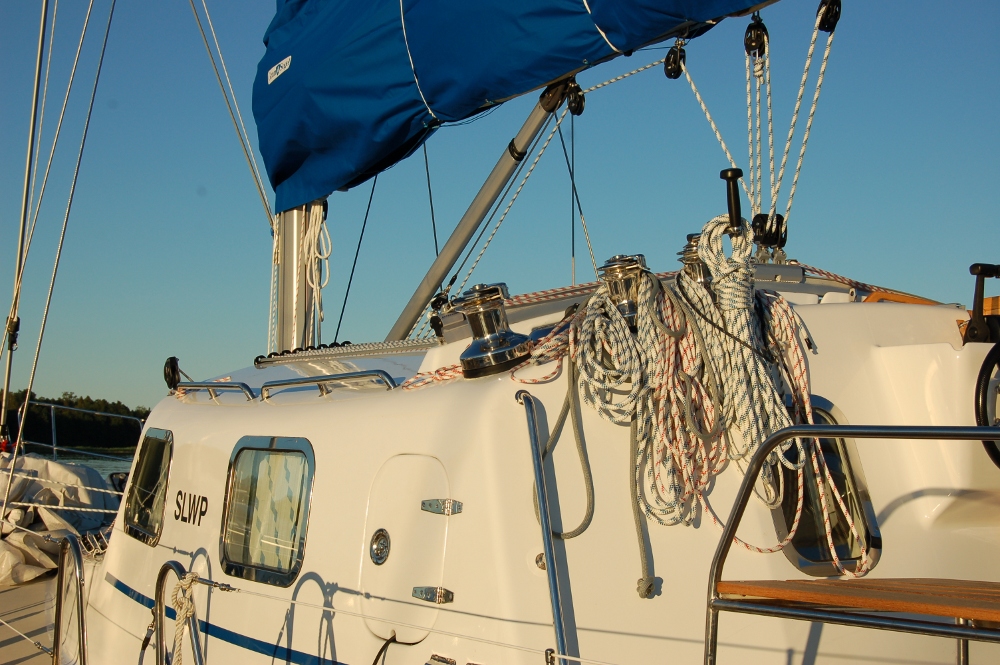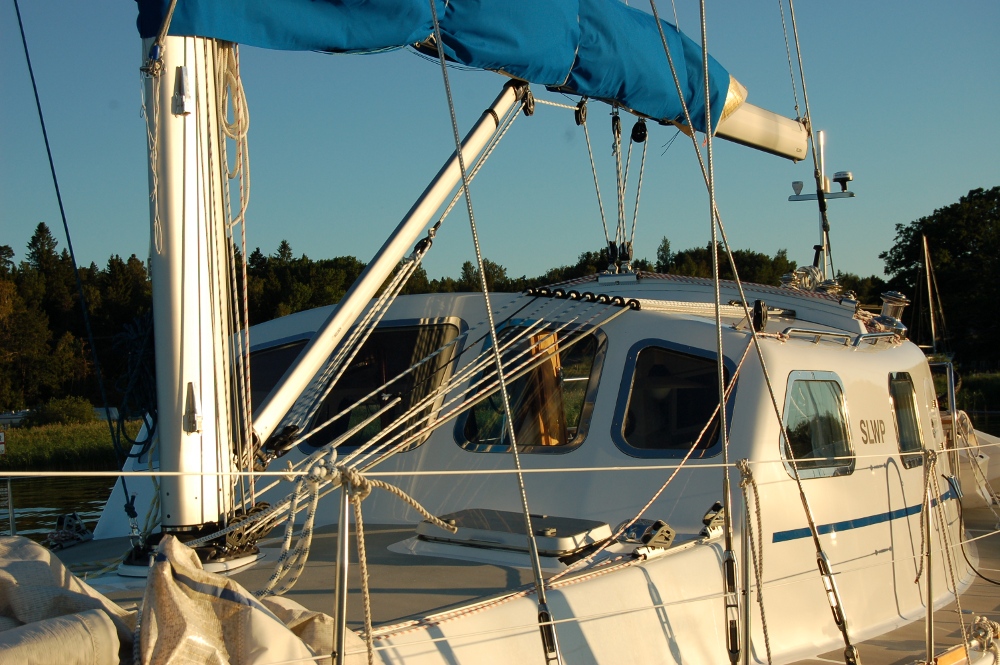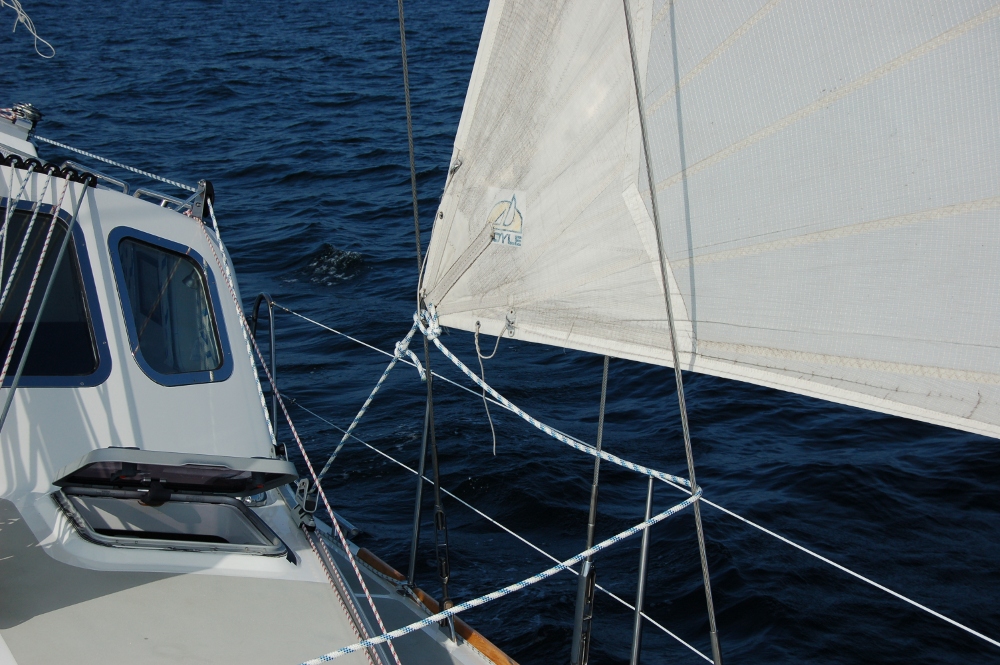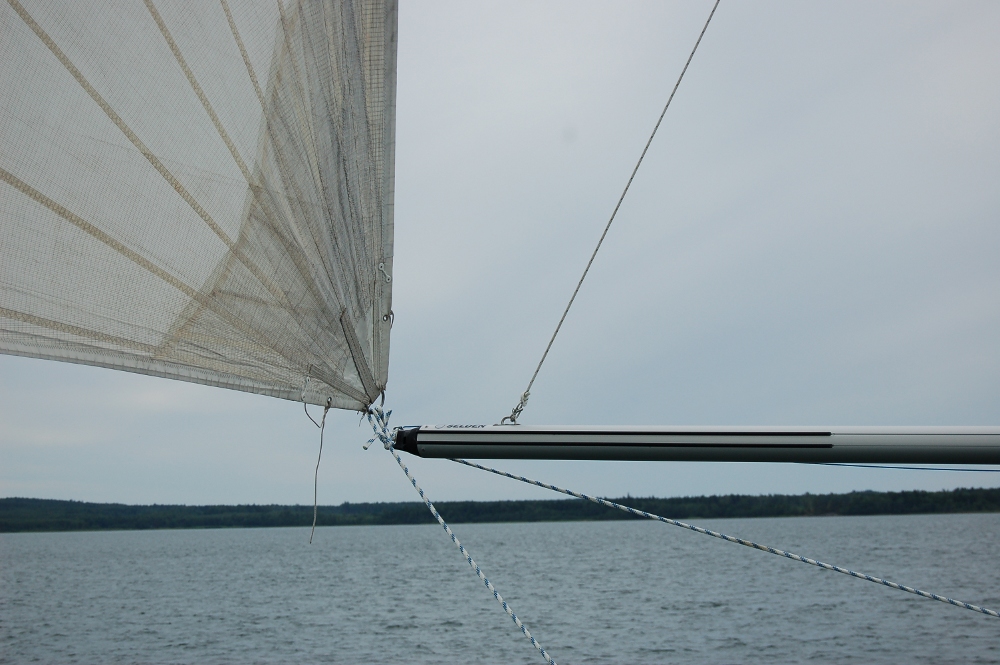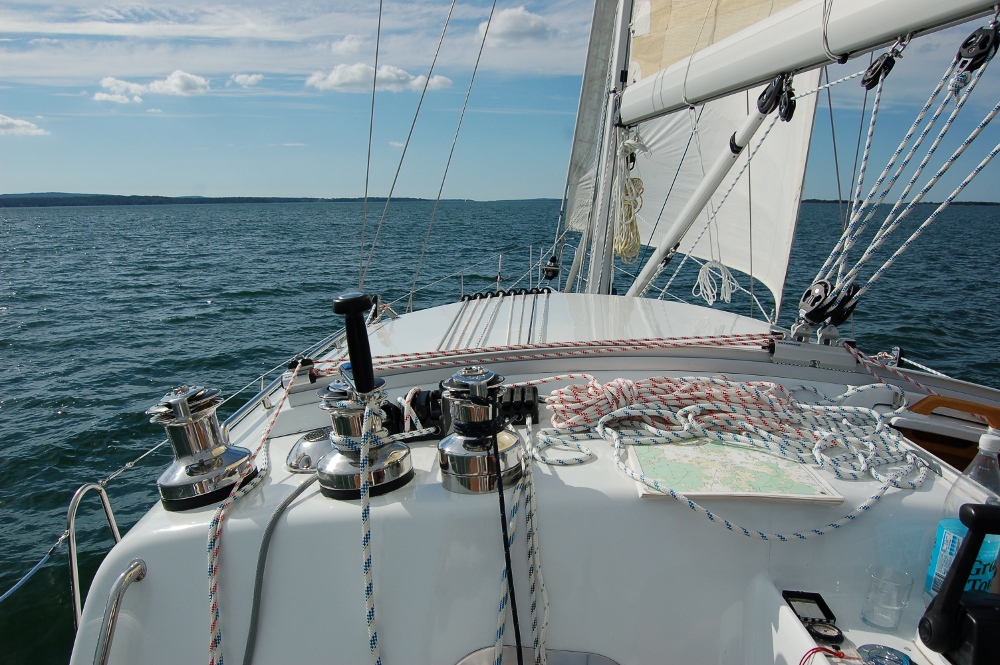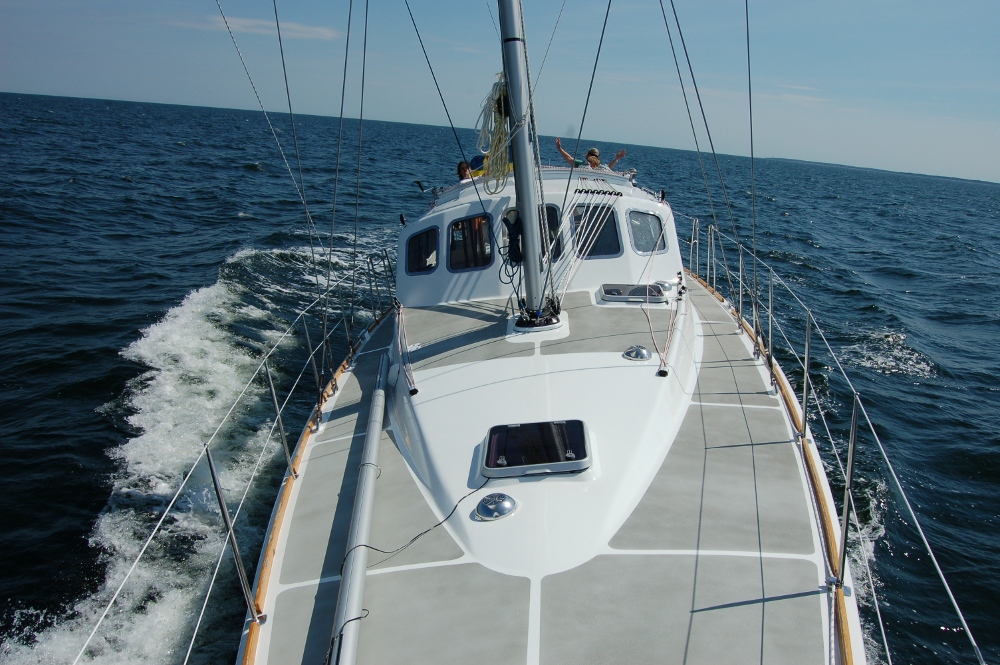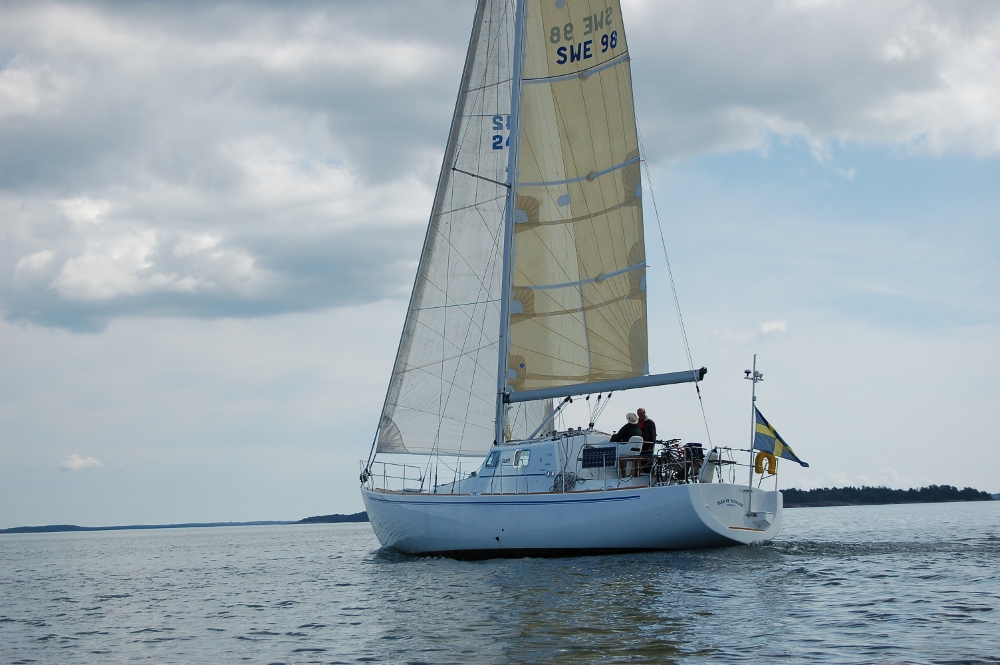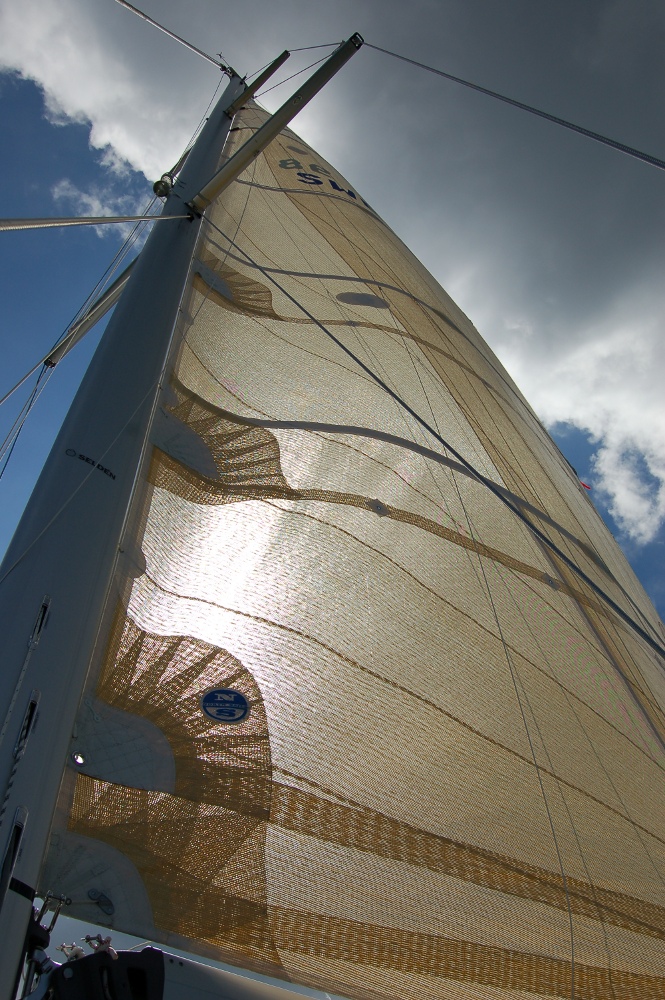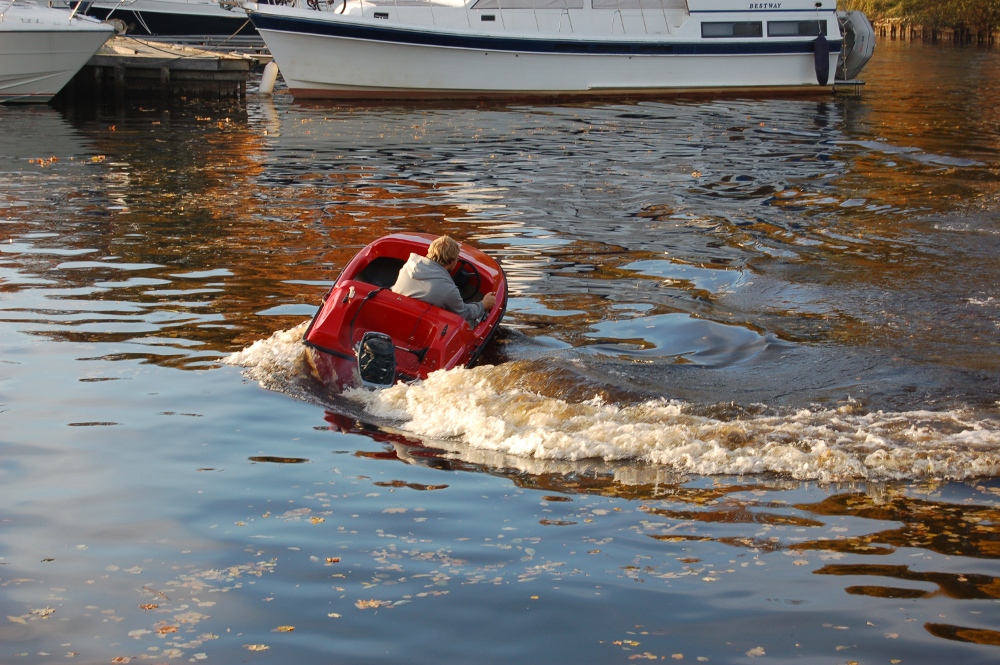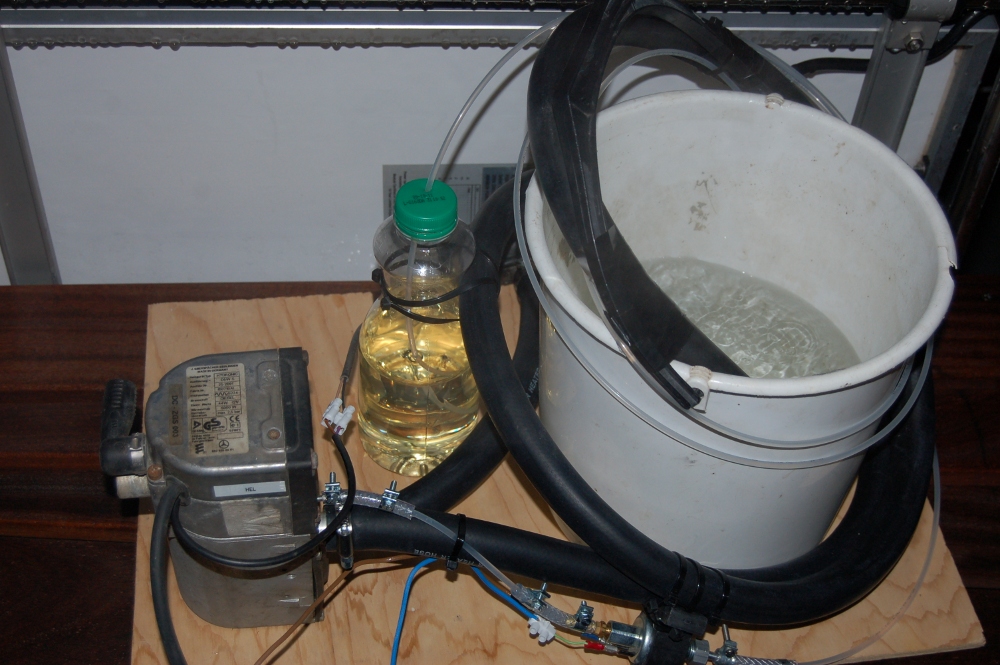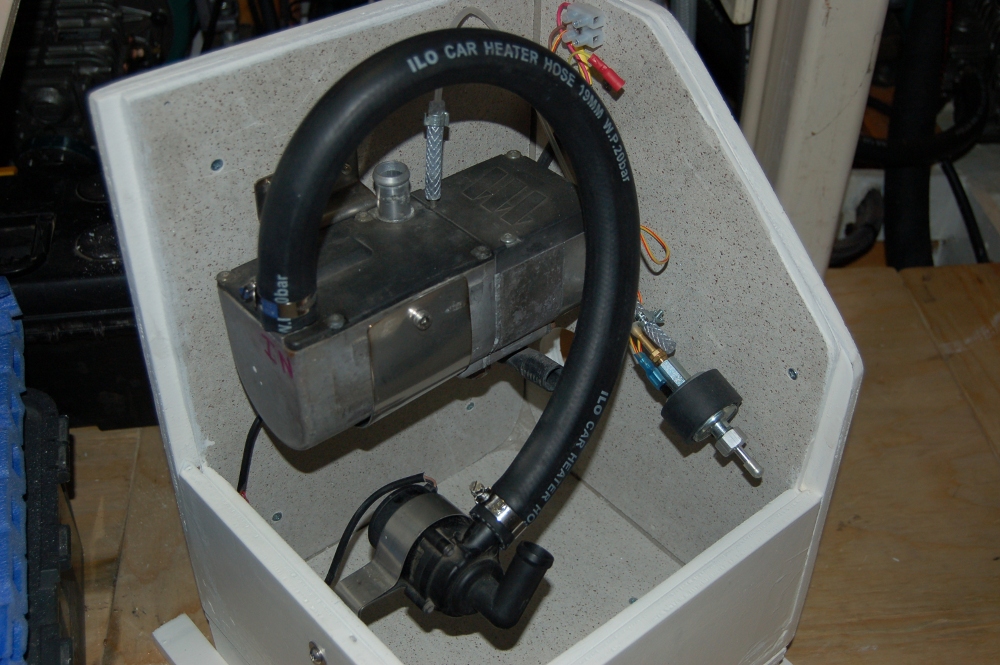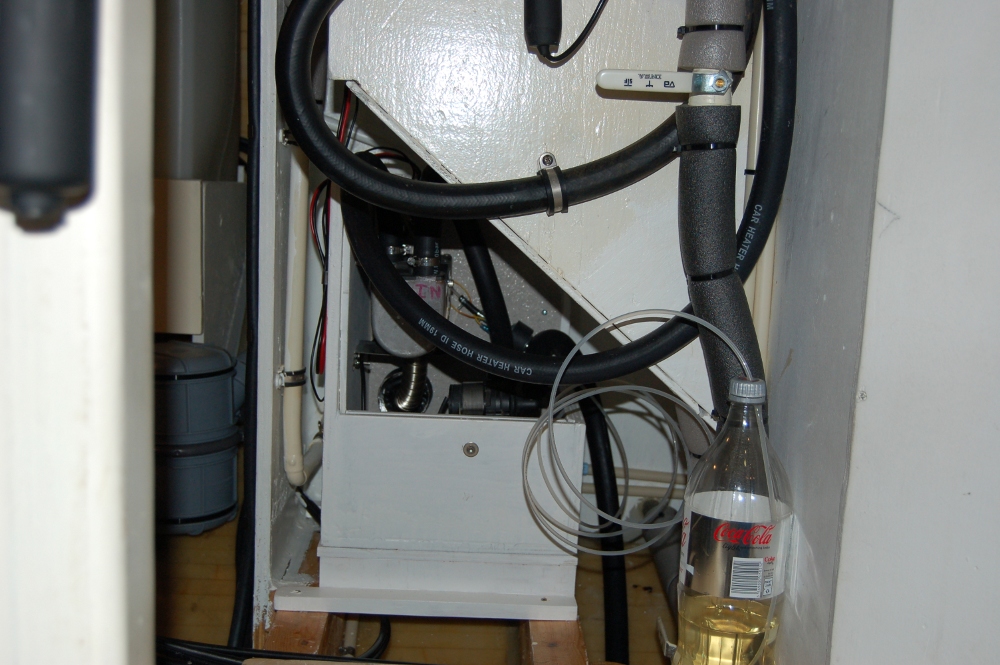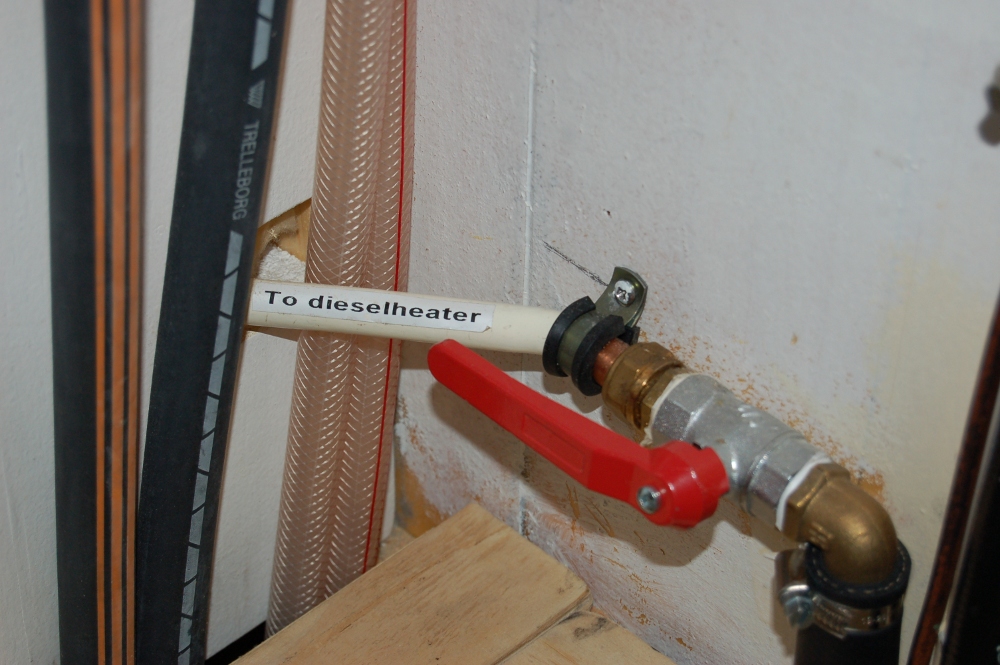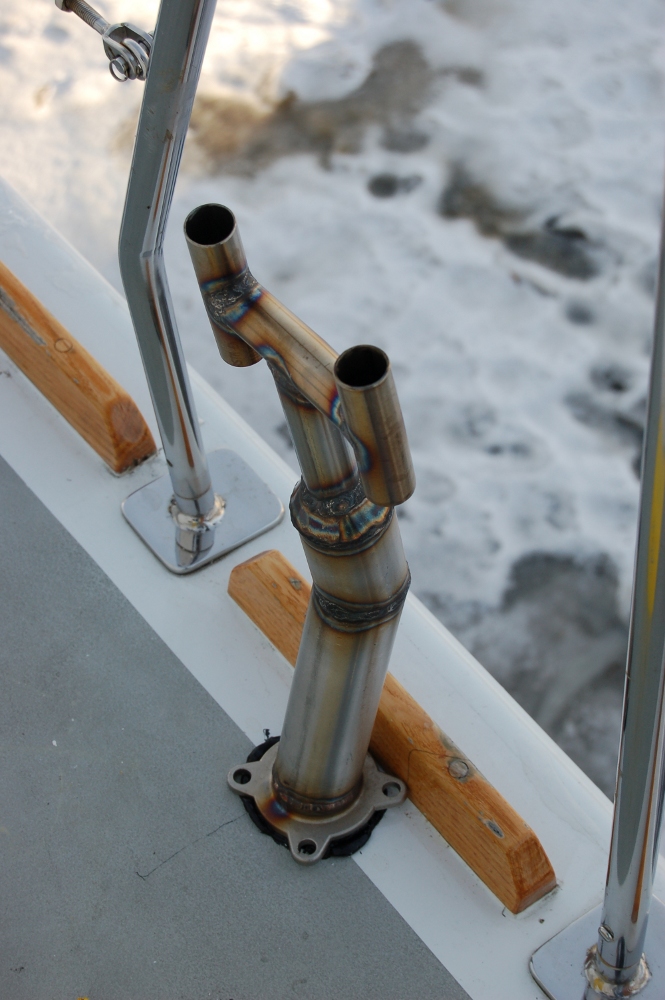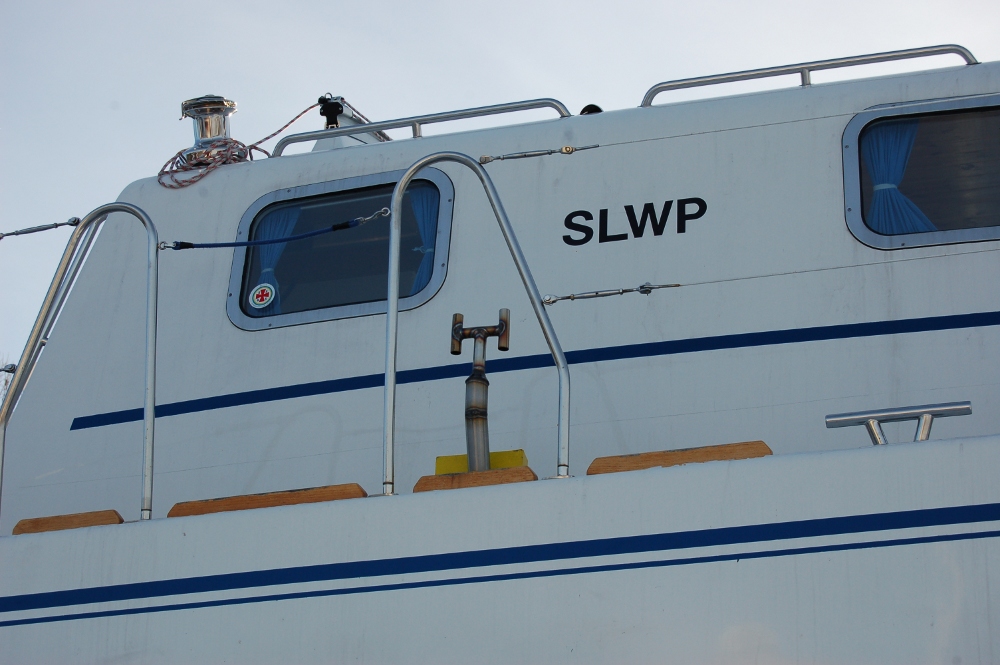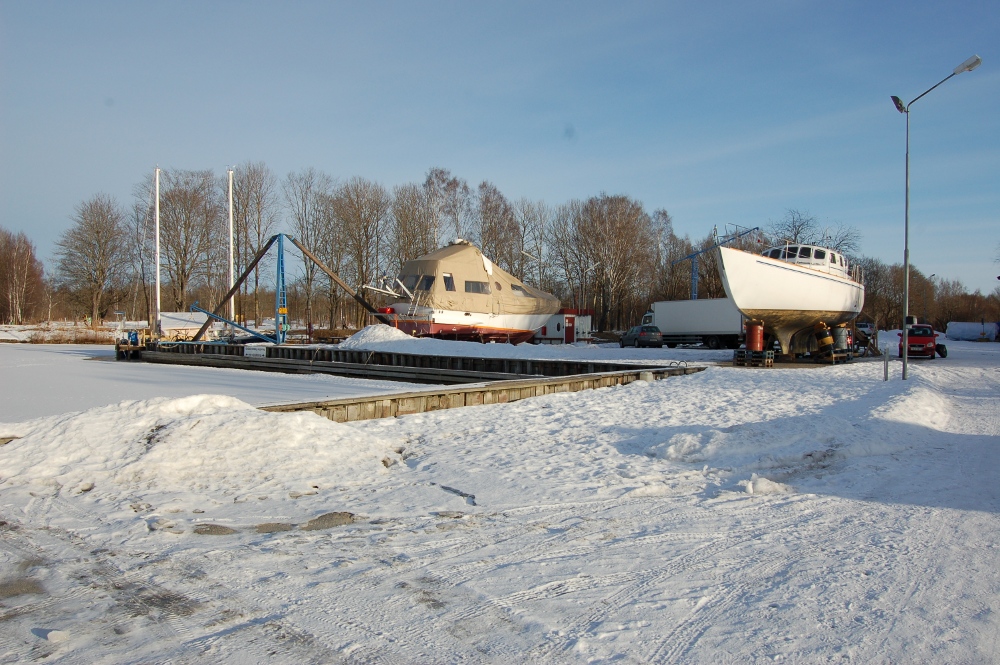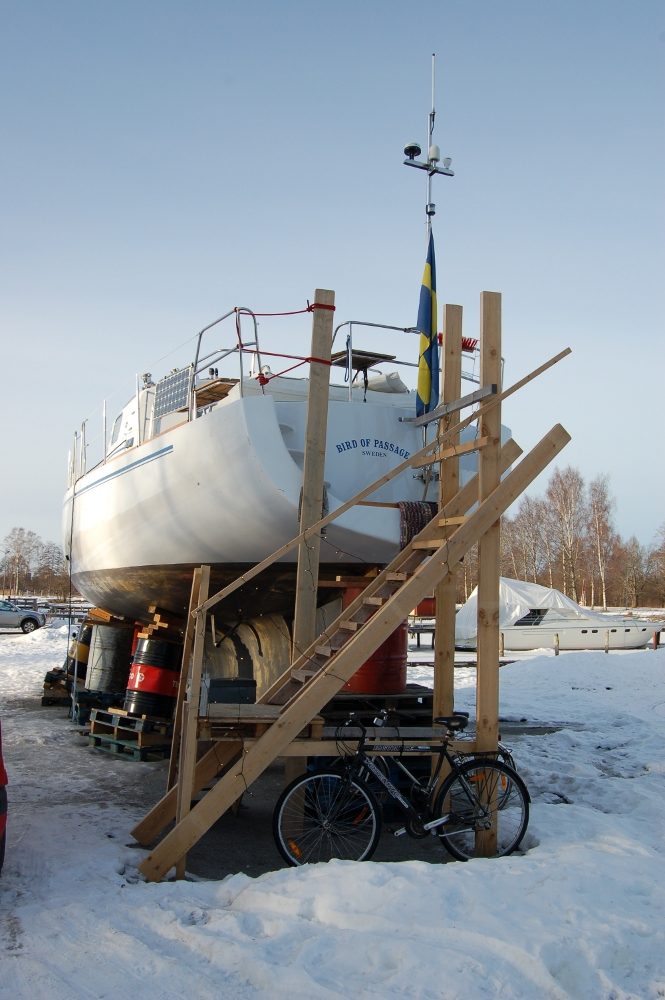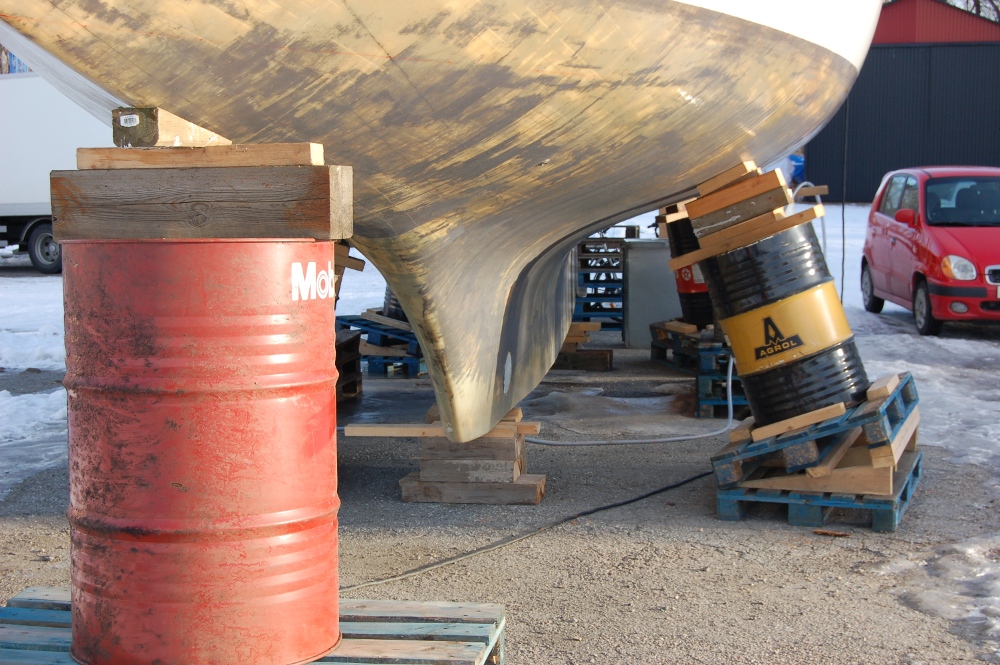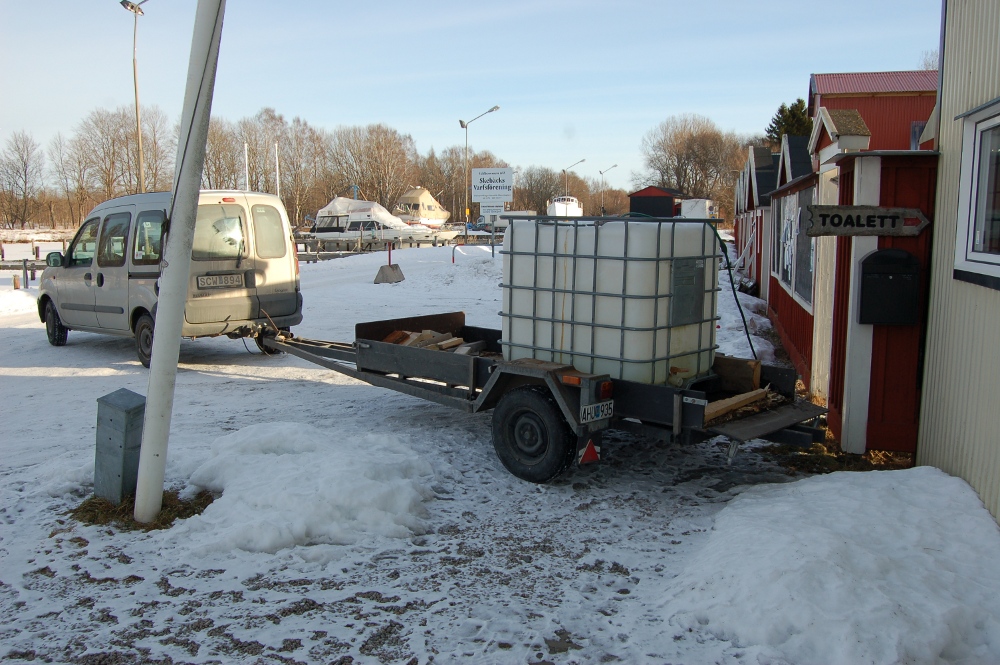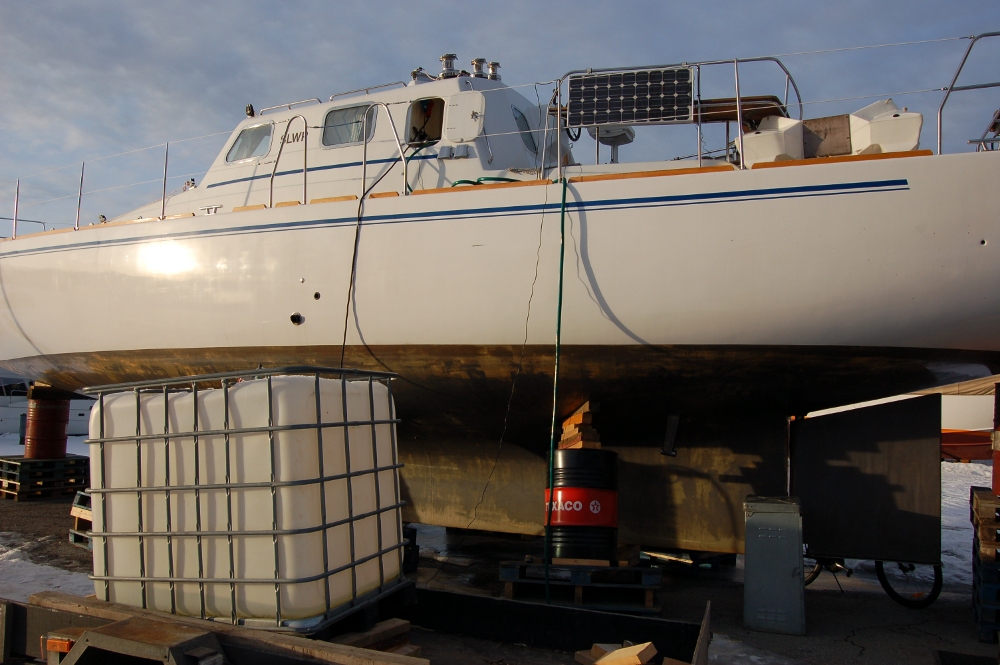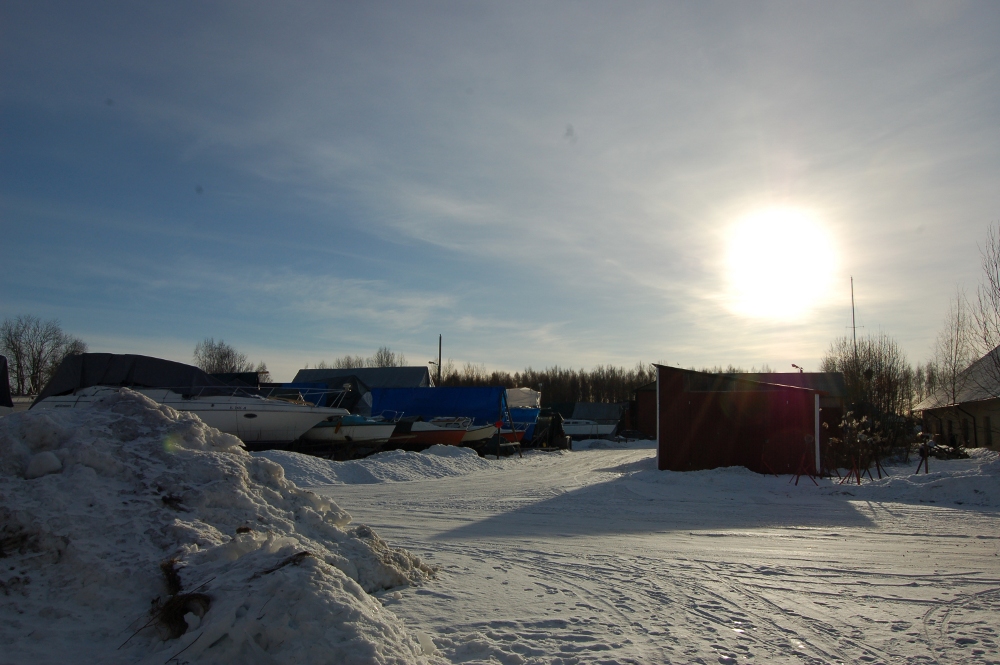
 2010
2010


Rigging 2010
by Johan Kjellander 2010, 2014
January to March
What a winter ! Snow and cold weather as never before. Here she is, frozen in, and covered by king Bore. We are now in the beginning of April and still there is ice left around us.
A good place to hide out and get warm is the machine room. This picture was taken with fish eye optics by a journalist from the local newspaper.
So, what's happening ? Well, we live here, at least half the family all the time and the rest during weekends and more. Somebody has to keep our house warm and feed the cat. Last weekend she was here. Her name is “Korven” which is not possible to translate. She's a long haired black cat born in a paper box in Martin's room 6 years ago and Tove immediately took her to her heart. I'm not that a big cat lover but I must admit Korven is special. Let's just hope she will adopt to boat living !
Million's of small jobs have been done inside the boat. Replacing traditional light bulbs, with LED's, curtains, Hi-Fi audio system (Logitech Z2300), web radio (Sagem My Web tuner 500), computer printer (HP 2400 printer/scanner/copyprinter), installed our old Navtex (Newcom NC-400), but the big job is the rig of course.
After asking for prices from 3 resellers this was the result:
Benns Mast: No answer even after 3 telephone calls..... :(
Skarven Mast: Answered by mail that he would contact me soon but never did.....:(
Doghouse Marine: Answered immediately and gave me prices from Selden and John Mast....:)
Our previous boat, Lynx, had a Selden rig. We sailed 35.000 NM and it never failed. Living in Sweden, choosing Selden as a rig supplier is not difficult. Doghouse Marine showed out to be a nice company. It's run by Gunnar Sahlin who is an experienced sailor and a good speaking partner. Today I ordered a Selden rig from him. It's expensive, yes, but hopefully also an investment and first of all, good quality. Gunnar has been very responsive to my needs. After many hours of discussion, this is where we ended:
C304 Mast profile 21.68 meters long.
Top fitting.
Double Spreaders.
Mast foot.
Single line main sail reefing (2 reefs, boom 7m).
Lazy jacks.
3 Mast steps (to reach boom).
Kick size 30.
Furlex 400 foresail reefing.
Jib boom 6.4 meter.
Rig screw 7/8”
Windex, Simrad wind sensors, Comrod AV 51-P VHF antenna, Lupolight LED anchor lantern, spreader lights, motor lantern etc. A lot of nice equipment. The rig will be mounted on Bird of Passage early June.
Soon the ice will be gone and we can mount the modified propellers. I really look forward to trying them out. Higher speed and no singing is what I expect. In July we will be sailing !!!!!!
April - June
The modification of the propellers turned out to be a big success ! The awful singing sound is totally gone and boat speed is increased by approximately 0.5 knots at 2000 rpm. Max motor speed at full throttle is now 3000 rpm. The recommendation from Volvo Penta is 2800 – 3200. Boat speed at full throttle is 8.8 knots. Cruising speed according to Volvo Penta should be 500 – 1000 rpm under full speed. This is equal to 2000 – 2500 rpm which gives a cruising speed of approx. 7 to 8 knots. Cruising at 7 knots will save fuel but it is nice to know that you can cruise at 8 knots without over stressing the motors.
The final order for the rig and deck hardware was mailed in the beginning of April. The first things to arrive was the deck hardware and we spent a lot of time in April and June to mount Andersen winches, Rutgerson main and genoa tracking systems, Spinlock rope clutches and a lot of other details. The plan was to have everything finished and prepared for the final rigging. The mast arrived to Doghouse Marine in Stockholm last week in June. A few days later the mast was ready for mounting. A few more days to mount the boom, the rod kick, Furlex and all other details and she was finally ready for sea. Here are some pictures:
With a completely unique boat and rig it is not easy to find sails that will fit perfectly. To avoid mistakes I decided to go for used (cheap) sails the first season and order new sails for next year. Finding used sails in this size was not easy but I finally managed to get hold of a main and a jib big enough at least for testing. Both are similar in size, a little more than 50 m2 each which is not enough in light winds, more like sailing with one or two reefs taken. The genoa is in bad condition but the main is really nice, made in Kevlar.
However, in winds like 5 m/s or more, Bird of Passage sails beautifully. So far we have sailed approx. 400 miles in all possible wind conditions except really strong winds over 15 m/s. Two things have surprised me. First of all, she doesn't heel. At least not very much. A 15 degrees of heeling she can sail 8 knots against the wind. And this is with the keel up (hydraulics are not yet finished so we can't lower the keel). As a matter of fact, heeling is so moderate that we tend to forget about it. This is very comfortable. Our previous boat (Lynx) could easily heel 30 degrees. Anything inside not properly secured would then fall down and sometimes get damaged. Bird of Passage moves so gently that you can have a cup of coffee standing on a table and forget about it until you reach port and the cup is still there in the same position.
Bird of Passage is now in Åland, Finland. A beautiful archipelago in the Baltic sea with lots of nice sailing. During August she will return to lake Hjälmaren in Sweden. In October we will take the mast down and return to the harbour in Örebro where she will spend another winter.
July - September
With the new rig (and used sails) we sailed approximately 500 nautical miles this summer, plus another 500 by motor. We have now returned to our home port Örebro in lake Hjälmaren. To reach our home port we need to pass under an electric power line which is only 20 meters above the water. With a rig that is 23 meters high this is not possible so we took the mast off in the harbor of Hampetorp, 20 miles east of Örebro and traveled the last bit by motor.
Many small jobs were finished during the summer. A job that was interesting was the external antenna for the mobile internet connection. We have a Huawei E169 modem and a Dovado USB Mobile Broadband Router. The E169 has an external antenna connector so I bought an expensive marine 3G antenna with 7 dBi amplification. See:
The idea was that with a powerful antenna we would get better internet connection and hopefully higher connection speed. I learned however that it is not quite as easy as that. First of all, the frequency of 3G is almost 2GHz which means that an antenna cable will reduce the signal substantially ! A cheap cable will eat 0.5 dBi for each meter ! This means that a cable of 14 meters (the length that we need) will eat 7 dBi which is exactly what the expensive antenna produces. There are more expensive cables however. We bought a 10 meter long very expensive super cable and moved the modem closer to the antenna using a 5 meter USB cable. This antenna cable has a 0.2 dBi reduction per meter and the 5 meter USB seems to work fine so we have at least 5 dBi left from the antenna. This seems to work fine. The router shows the signal strength and it increases significantly with the new antenna connected. What this means in connection speed I do not know, it's not easy measure but the theory says that higher signal strength means better speed so I am happy. Most of the time playing World of Warcraft is no problem but sometimes the response time is too slow for serious raiding.
Bird of Passage is a sailboat and she will not run as fast as a motor boat. Martin, our oldest son, wanted some fun and found a small speedboat with a 15 hp Evinrude on internet. Runs like a rocket ! His plan is to take it on board when we leave Sweden next year. We already have a dinghy with a 2 hp Yamaha so with the speedboat we will be well equipped ! BTW we do not know the brand of the speedboat (maybe Jerry) so if anyone recognizes it, please let us know.
Bird of Passage will be on the dry this winter. Living in a boat on land has several disadvantages compared to when the boat is in the water but we all like living in BoP and there are also jobs that need to be done. One job is installing a diesel heater in the hot water system. Other jobs are windlass, bimini, keel hydraulics, new sails, antifouling and many other details.
October - January
By the end of October we lifted Bird of Passage to stay on the dry for the winter. After only a few days the weather turned really cold and the ice settled in the harbor. Living in a boat on land is very different than living in a boat in water. Colder, more difficult to board, less comfortable in many ways. If it were not for the under water jobs that needed to be done with the boat on land we would have preferred staying in the water.
With the cold weather going on we spent most of the time working inside the boat. A big job this period was to install a diesel heater. A friend of mine had a number of old Eberspaecher 5 kilowatt diesel water heaters that were not working but by carefully testing them and exchanging parts I managed to get a few of them running.
These heaters need an external fuel pump and water pump of the right kind to function properly. I bought a second hand water pump that worked well and a new fuel pump. Then I built a test rig to run the heaters. With a heater working I continued and built a ”Heater box” with fire resistant material and the two pumps mounted inside.
Finally I mounted everything in the machine room and connected it to the heating system. To get the exhausts safely outside and keep water from coming in I built this little cute chimeny. It's not polished yet, only temporary fitted to verify that everything is working. Yesterday evening we turned the heater on for the first time and everything worked fine. I was surprised with the noise level, much lower than I expected. No problem to sleep with this heater running. We now have three heat sources connected to our heating and hot water system, a 3 kW electric heater, the new 5 kW diesel heater and also one of the two engines.
Here are some pictures of the boat and the harbor in late January 2011.
Finally some pictures from todays job, filling the water tanks. Because of the freezing temperatures there is no water available close to the boat. Only way is to get water somewhere else and transport it. With 800 liters of water tanks to fill you need something big for transportation and then you need a powerful pump to get the water into the boat tanks.
It is now January 30. This nice picture was taken by Martin at noon today. Our position is 60 degrees north and the sun is at its highest position.
